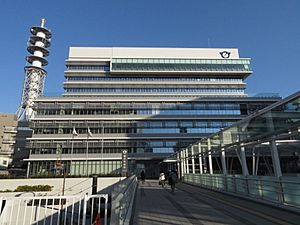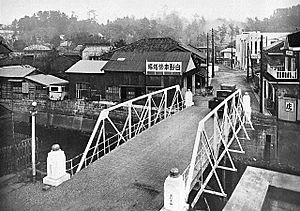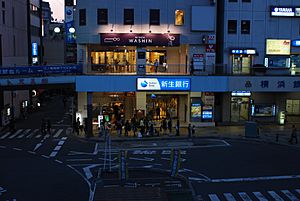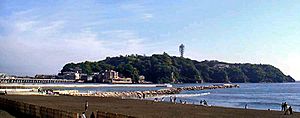Fujisawa, Kanagawa facts for kids
Quick facts for kids
Fujisawa
藤沢市
|
|||
|---|---|---|---|
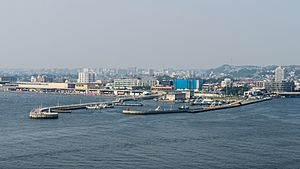
A panorama view of Fujisawa, from Enoshima seaside
|
|||
|
|||
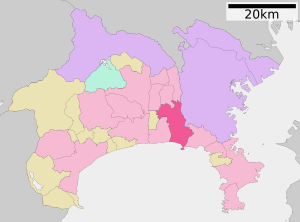
Location of Fujisawa in Kanagawa Prefecture
|
|||
| Country | Japan | ||
| Region | Kantō | ||
| Prefecture | Kanagawa Prefecture | ||
| Area | |||
| • Total | 69.57 km2 (26.86 sq mi) | ||
| Population
(February 1, 2015)
|
|||
| • Total | 420,254 | ||
| • Density | 6,040/km2 (15,600/sq mi) | ||
| Time zone | UTC+9 (Japan Standard Time) | ||
| – Tree | Japanese black pine | ||
| – Flower | Wisteria | ||
| – Bird | Common kingfisher | ||
| Phone number | 0466-25-1111 | ||
| Address | 1 Asahi-cho, Fujisawa-shi, Kanagawa-ken 251-8601 | ||
| Website | http://www.city.fujisawa.kanagawa.jp/ | ||
Fujisawa (藤沢市, Fujisawa-shi) is a cool city located in Kanagawa Prefecture, Japan. It's a vibrant place with a mix of city life and beautiful nature.
As of April 2018, about 429,317 people lived here. This means there are about 6,171 people living in each square kilometer. The total area of Fujisawa is 69.57 square kilometers.
Contents
Geography of Fujisawa
Fujisawa is in the middle part of Kanagawa Prefecture. It sits right on the coast, facing Sagami Bay, which is part of the huge Pacific Ocean. The northern part of the city is a flat area called the Sagamino plateau. The southern part has sandy areas known as the Shonan Dunes.
Natural Features
Fujisawa has three main natural features that make it special.
- The island of Enoshima is to the south. A road bridge connects it to the Katase shoreline.
- Two important rivers, the Hikiji and the Sakai, flow from north to south through the city.
The Hikiji River starts in a nature reserve park in Yamato city. It flows along the edge of the US Navy and Japan Maritime Self-Defense Force's Atsugi Naval Air Base. The Sakai River starts in the mountains between Machida and Hachiōji. For a long way, it forms the border between Tokyo and Kanagawa Prefecture. You can follow a foot and bike path along the Sakai River from Machida city center to Fujisawa city center. This path is about 35 kilometers long! There's also a bike path along the Shonan Coast. It goes from the Sagami River in Hiratsuka to Enoshima Bridge in Fujisawa.
Neighboring Cities
Fujisawa shares its borders with several other cities in Kanagawa Prefecture:
History of Fujisawa
People have lived in the area around Fujisawa for thousands of years. Scientists have found old stone tools and shell piles from the Japanese Paleolithic period. They also found pottery from the Jōmon period and ancient graves from the Kofun period.
Early Times
The area is even mentioned in old Japanese writings from the Nara period. By the Heian period, local leaders controlled different parts of the land. During the Kamakura period, Fujisawa was a place where many battles happened. These battles were fought to try and overthrow the Kamakura government. In the Muromachi period, Fujisawa grew around a Buddhist temple called Yugyo-ji, which was built in 1325.
Edo Period and Beyond
During the Edo period, Fujisawa became a busy "post station" called Fujisawa-shuku. This was a stop on the Tōkaidō highway, which connected the big cities of Edo (now Tokyo) and Kyoto. Even the Shōgun Tokugawa Ieyasu had a special palace in Fujisawa where he could rest.
After the Meiji Restoration, the area was divided into smaller villages. Fujisawa grew quickly after the Fujisawa Station opened in 1887. In 1908, several villages joined together to form Fujisawa Town.
Modern Growth
A big earthquake in 1923, called the 1923 Great Kantō earthquake, caused a lot of damage in Fujisawa. Many houses were destroyed. Fujisawa officially became a city on October 1, 1940. Over the years, it grew by adding more villages and towns. Fujisawa was even a host city for the 1964 Summer Olympics, holding the yachting events!
Today, Fujisawa is a popular place for people who work in Tokyo and Yokohama. Good train lines, like the Yokohama Subway and Odakyu line, make it easy to travel.
Economy of Fujisawa
Fujisawa has a strong and varied economy. This means it has many different types of businesses and industries.
Major Industries
- Isuzu has a large factory in Tsuchidana that makes trucks.
- Kobe Steel has a factory in the eastern part of the city.
- NSK Microprecision makes tiny parts and bearings here.
- Sony has its Shonan Technology Center in Fujisawa.
- Ebara Corporation, a big company that makes pumps and water treatment equipment, also has a factory in Fujisawa.
Fujisawa also has many shops and is the biggest shopping area on the Shonan coast. Because it's easy to get to, many people who work in Yokohama and Tokyo choose to live in Fujisawa.
Transportation in Fujisawa
Fujisawa has excellent public transportation, especially trains. This makes it easy to travel within the city and to other parts of Japan.
Railway Lines
- JR East operates the Tōkaidō Main Line and Shōnan-Shinjuku Line.
- Stations: Fujisawa, Tsujidō
- Odakyu Electric Railway runs the Odakyū Enoshima Line.
- Stations: Chōgo, Shōnandai, Mutsuai-Nichidaimae, Zengyō, Fujisawa-Hommachi, Fujisawa, Hon-Kugenuma, Kugenuma-Kaigan, Katase-Enoshima
- Enoshima Electric Railway (Enoden) is a scenic line.
- Stations: Enoshima, Shōnankaigankōen, Kugenuma, Yanagikōji, Ishigami, Fujisawa
- Sagami Railway has the Izumino line.
- Station: Shōnandai
- Yokohama Municipal Subway's Blue Line also serves the city.
- Station: Shōnandai
- Shonan Monorail is a unique suspended monorail.
- Stations: Mejiroyamashita, Shōnan-Enoshima
Education in Fujisawa
Fujisawa has many schools for students of all ages.
High Schools
- Shonan High School is a well-known school.
- Shonan Shirayuri Gakuen Junior High School and High School is a private school.
Universities
There are four university campuses in Fujisawa:
- Keio University has its Shonan Fujisawa Campus (SFC) with three different study areas.
- Nihon University has a School of Natural Science.
- Tama University has a Global Studies Faculty.
- The Shonan Institute of Technology (SIT) is located in Tsujido Nishikaigan.
Hospitals
- Fujisawa City Hospital is an important medical center in the city.
Sister City Relations
Fujisawa has special friendships with cities around the world. These are called "sister city" relationships.
 Miami Beach, Florida, USA (since 1959)
Miami Beach, Florida, USA (since 1959) Matsumoto, Nagano, Japan (since 1961)
Matsumoto, Nagano, Japan (since 1961) Kunming, Yunnan Province, China (since 1981) - This is a "Friendship city" relationship.
Kunming, Yunnan Province, China (since 1981) - This is a "Friendship city" relationship. Windsor, Ontario, Canada (since 1987)
Windsor, Ontario, Canada (since 1987) Boryeong, South Chungcheong Province, South Korea (since 2002)
Boryeong, South Chungcheong Province, South Korea (since 2002) Yalta, Crimea, Ukraine
Yalta, Crimea, Ukraine
Local Attractions
Fujisawa is famous for its "Shōnan lifestyle." This means it's a popular place for people who enjoy the beach and outdoor activities. Many people from the Kanto region visit Fujisawa for day trips.
Beach Fun
- Surfing and beach volleyball tournaments are held here in the summer.
- Temporary bars and restaurants open along the beach from Kugenuma Kaigan to Enoshima Kaigan.
- Fujisawa has two big fireworks shows in late July and early August.
Enoshima Island
Enoshima Island has lots to see and do:
- It has beautiful botanical gardens.
- You can visit the Enoshima Lighthouse. From the top, which is 119.6 meters above sea level, you get amazing views of the area. On a clear day, you can even see Mount Fuji!
- There are famous Shinto shrines on the island, some inside caves.
Local Food
One popular food from Fujisawa is shirasu. These are tiny, soft fish, similar to whitebait.
Other Tourist Spots
- Shirahata Shrine: This Shinto shrine is dedicated to Samukawahiko-no-Mikoto and Minamoto no Yoshitsune. It has two special portable shrines.
- Shōjōkō-ji (Yugyo-ji): This is a very important Buddhist temple.
- Kugenuma Beach: A great place for swimming and relaxing.
- Site of Oba Castle: This used to be a castle, but it's gone now. It's a good spot for Hanami (cherry-blossom viewing) in late March.
Notable People from Fujisawa
Many talented people come from Fujisawa, including:
- Rika Fujiwara, a professional tennis player
- Tsubasa Imai, a singer and actor
- Masahiko Kageyama, a racing driver
- Masahiro Nakai, a singer and actor
- Nagisa Oshima, a famous film director
- Go Soeda, a professional tennis player
- Kohei Suwama, a professional wrestler
- Saki Takaoka, an actress
Related pages
Images for kids
See also
 In Spanish: Fujisawa para niños
In Spanish: Fujisawa para niños





